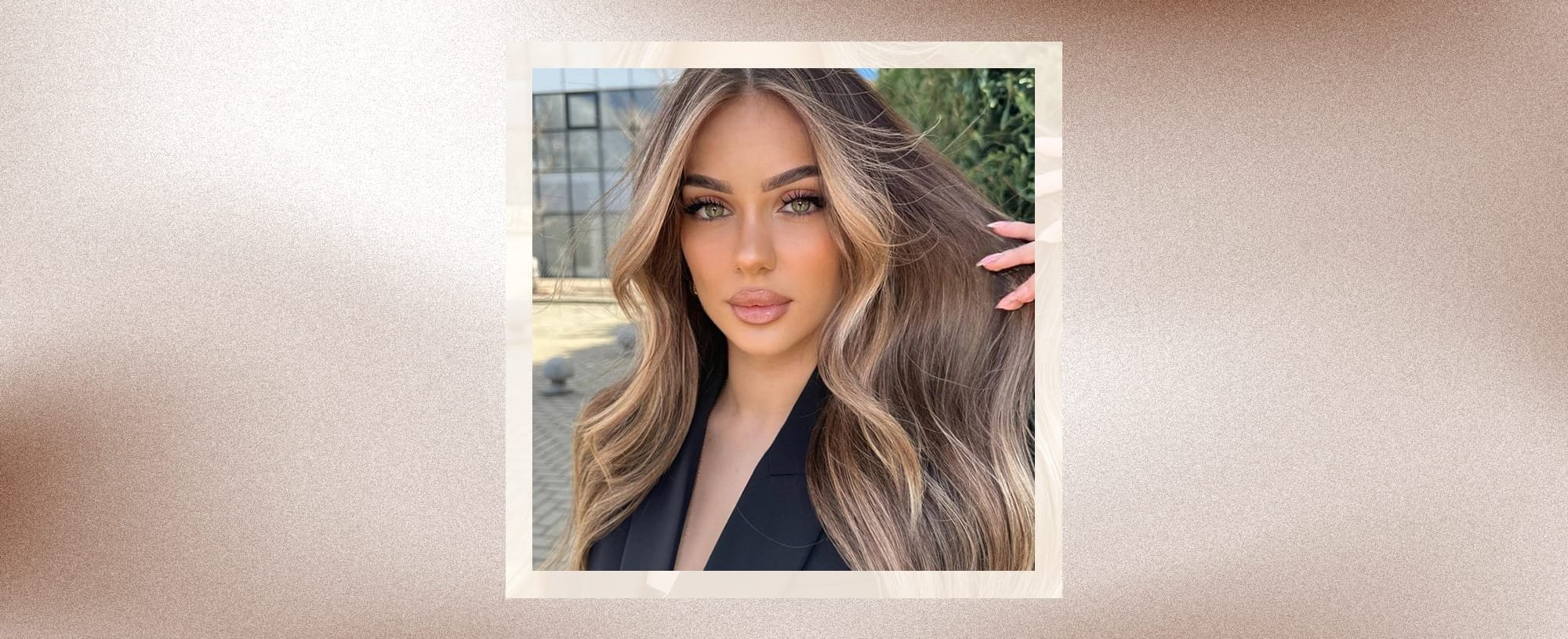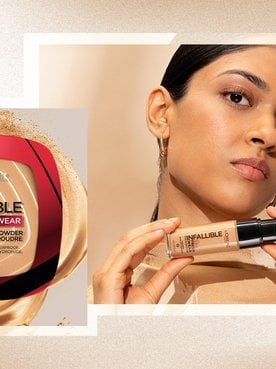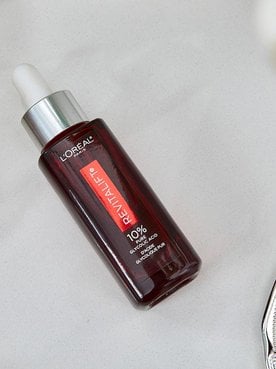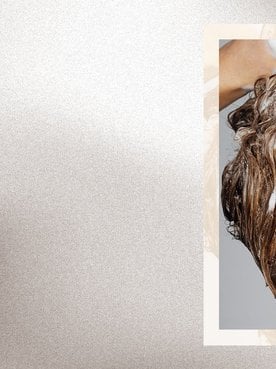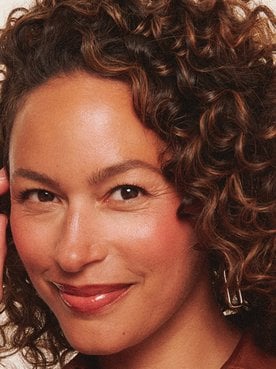You’ve likely heard of volumizing shampoo, purple shampoo, and maybe even bonding shampoo. But blue shampoo is another, lesser-known, type of shampoo on the market—and it can seriously benefit all the lightened brunettes out there. Rest assured, it won’t turn your strands blue: What it can do is help them look shiny and vibrant between coloring sessions. Ahead, we’re breaking down what exactly this colorful formula does, plus how often to use blue shampoo in your haircare routine. Keep scrolling for the full scoop.
What Is Blue Shampoo?
Blue shampoo is a haircare formula specifically made to help tone brassy brown hair. The tinted formula deposits cobalt or indigo-colored pigments onto hair’s surface to help eliminate unwanted orange tones, restoring brunette locks to a cooler, more neutral color. The concept goes back to color theory: Blue and orange are contrasting shades that can help cancel each other out when combined.
Blue shampoo isn’t just for color-treated, light brown hair, either. Darker blondes and those with deep brown virgin hair can also use blue shampoo to help their manes appear richer, balanced, and more vibrant.
Blue vs. Purple Shampoo
Both blue and purple shampoos are color-correcting products that can help minimize visible brass in color-treated hair. What differentiates them, however, is the shade of brass they’re designed to target. Purple shampoo offsets yellow undertones that can appear in lighter hair colors (ranging from platinum blonde to gray), whereas blue shampoo counteracts orange tones that can crop up in brunettes. Choosing between blue or purple shampoo ultimately boils down to how light or dark your hair color is. This brings us to our next point…
Can you use blue shampoo on blonde hair?
While you can sometimes use purple shampoo on certain shades of brown hair, the inverse generally isn’t true for using blue shampoo on blonde hair. That’s because purple shampoo can help tone and sharpen highlighted accents in brown hair (think balayage or ombré) without “staining” the darker areas of your hair with purple pigment. When you use blue shampoo on light blonde hair, on the other hand, the saturated dyes can make pale strands appear gray, ashy, or even slightly blue in color.
Will blue shampoo lighten brown hair?
It’s important to note that blue shampoo (and purple shampoo, for that matter) can’t lift or lighten your strands. These types of toning shampoos can only deposit temporary pigments onto your hair’s surface to help balance, refresh, and brighten existing highlights and hair color. If lightening your hair further is your goal, you’ll have to head to the salon or pick up an at-home bleaching kit to get your desired result.
How Often Should You Use Blue Shampoo?
You shouldn’t use blue shampoo as frequently as your regular shampoo—only as needed to reduce visible brass. Typically, washing with blue shampoo results in an instant brightening effect that can eliminate orange tones for 2-3 washes. However, applying more blue shampoo before the effects of the first application fade can backfire: With no more orange to adhere to, depositing more blue pigment onto your hair shaft can actually darken your strands or make your color appear muddy. As such, try to swap a blue shampoo into your routine about once a week to reap its benefits without risking discoloration. If you go overboard, you can use a clarifying shampoo to help remove unwanted pigment.
How To Use Blue Shampoo
Using a blue shampoo on brown hair is fairly straightforward, but the instructions can vary depending on your chosen formula. We always recommend reading the label of your shampoo to gauge whether there are any specific directions to follow. When you’re ready to suds up with your brilliantly-toned shampoo, here’s a general breakdown of how to do so.
1. Decide how much to apply
Knowing when to use blue shampoo is only part of the puzzle—you’ll also have to determine how much you’ll need to apply. Spoiler: It’s usually a bit more than a traditional cleansing shampoo. Regular shampoo generally should be concentrated on your roots and scalp to help wash away oils and other buildup—you don’t need to use enough to coat your entire head of hair. Blue shampoo, meanwhile, is best applied from roots to ends to ensure the blue pigments are evenly distributed throughout your hair, which calls for more product.
Typically, shorter hair needs about a dime-sized amount of blue shampoo, while longer lengths require about a quarter. There isn’t a definitive rule, though. See how much is needed to saturate your hair, then tailor your application approach accordingly.
2. Apply from scalp to ends
Most blue shampoos still offer cleansing benefits, so be sure to gently knead the formula into your scalp to help dislodge any buildup. Then, massage the shampoo through your lengths so the blue pigments can fully envelop your hair. Based on what the packaging indicates, let the lather sit on your strands for the allotted amount of time before rinsing.
3. Follow with conditioner
Whatever your hair type, you shouldn’t skip conditioner—especially when you have color-treated hair. If your blue shampoo has a corresponding blue conditioner, use that to maximize the toning benefits. If not, opt for a conditioner or hair mask to help restore shine and softness to your mane.
For dry hair, consider the L’Oréal Paris EverPure Sulfate Free Moisture Conditioner to deeply replenish hair with moisture and keep color pure for up to four weeks. Those with damaged hair, such as highlighted brunettes, can try the L’Oréal Paris EverPure Sulfate Free Bond Repair Conditioner to help rebuild weakened hair bonds and strengthen strands.
Work your conditioner from the mid-shaft to the ends of your hair, avoiding the roots. Let it sit according to the label’s directions, and rinse.
Shop the Products
4. Treat hair to a leave-in
After showering and towel-drying your hair, apply a leave-in like L'Oréal Paris Elvive Hyaluron + Plump Moisture Plump Serum to damp hair for added moisture and hydration. A little goes a long way here, so just dispense a dime-sized amount into your hands and apply it to the lengths and ends of your hair.
If you plan to reach for hot tools post-washing, always use a heat protectant first and turn your stylers to their lowest temperature settings. Heat styling can quickly dull your hair color—and that’s likely the last thing you want after toning your tresses. Apply a heat protectant, like the L'Oréal Paris EverPure Sulfate-Free Weightless Blow Dry Primer, to clean, damp hair before creating your desired look.
Shop the Products
Next Up: How To Manage Brassy Orange Tones on Lightened Hair
Photo Credit: IG @anderrateliehair
